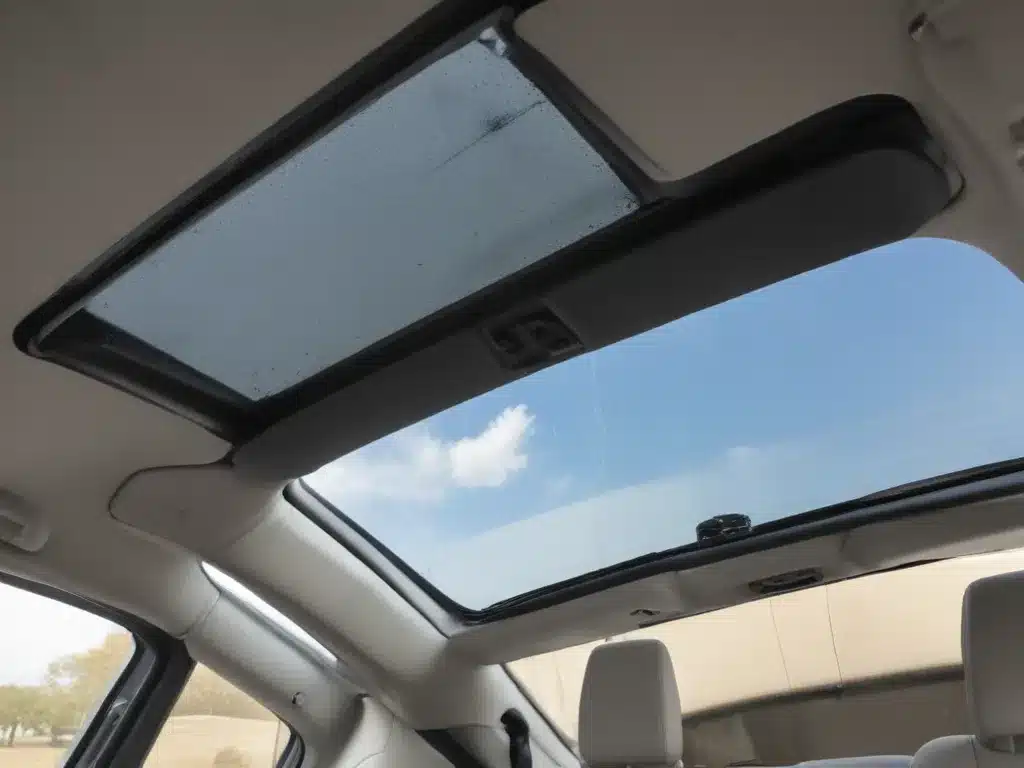
Dealing with a Leaky Sunroof: My Journey to a Dry Ride
I’ll never forget the day my beloved car started showing signs of a sunroof leak. It was a rainy afternoon, and as I was driving down the highway, I noticed a few ominous drops of water forming on the dashboard. My heart sank – I knew this could only mean one thing: my sunroof was leaking.
As an avid car enthusiast, the idea of dealing with a leaky sunroof filled me with a sense of dread. I had always prided myself on keeping my vehicle in tip-top shape, but this was a problem I hadn’t encountered before. With a deep breath, I knew I had to take action and get to the bottom of this issue.
Identifying the Source of the Sunroof Leak
The first step in tackling a sunroof leak is to identify the source. This can be tricky, as water can often travel along crevices and seals before actually dripping into the cabin. I decided to start my investigation by carefully inspecting the sunroof itself.
I began by thoroughly cleaning the sunroof and the surrounding areas, ensuring there was no debris or obstructions that could be causing the leak. I then meticulously checked the seals and gaskets for any signs of wear, cracks, or damage. To my dismay, I noticed a few areas where the seal had begun to deteriorate.
Next, I turned my attention to the sunroof’s drainage system. Sunroofs are designed with small channels and tubes that are meant to divert water away from the cabin. However, if these become clogged or damaged, it can lead to water backing up and finding its way inside.
I used a flexible inspection camera to take a closer look at the drainage system, and sure enough, I discovered a few blockages caused by leaves and other debris. This was clearly a contributing factor to the leak.
Fixing the Sunroof Leak
Now that I had identified the potential sources of the leak, it was time to tackle the repair. I knew this would likely involve a combination of replacing the seals and cleaning out the drainage system.
First, I carefully removed the sunroof trim and gaskets, taking note of how they were installed to ensure I could put them back properly. I then inspected the seals and decided that a full replacement was necessary. I ordered the appropriate sunroof seal kit and set about carefully installing the new components.
With the seals taken care of, I turned my attention to the drainage system. Using a small wire brush and a can of compressed air, I meticulously cleared out any debris that had accumulated in the channels and tubes. I also checked to make sure the drainage outlets were unobstructed and allowing water to flow freely.
After completing these repairs, I took my car out for a test drive in the rain, eagerly anticipating a dry interior. To my delight, the sunroof no longer leaked, and I could enjoy the sights and sounds of the open road without any unwanted drips.
Maintaining a Leak-Free Sunroof
Of course, the work didn’t end there. Preventing future sunroof leaks requires ongoing maintenance and vigilance. I now make it a point to regularly check the seals and drainage system, ensuring they remain in good condition.
I also recommend that all car owners with sunroofs perform a similar inspection at least once a year, or whenever they notice any signs of a leak. It’s a small investment of time that can save you from dealing with the hassle and potential damage caused by a malfunctioning sunroof.
Preventing Sunroof Leaks: Tips and Tricks
In addition to the maintenance routine I’ve established, I’ve also learned a few other tricks to help keep my sunroof leak-free:
-
Regularly Clean the Sunroof and Drainage System: Don’t let debris and grime build up, as this can clog the drainage and compromise the seals. Make it a habit to clean these areas every few months.
-
Inspect for Damage After Extreme Weather: Heavy rain, hail, or even high winds can cause damage to the sunroof seals and components. Be sure to give it a thorough inspection after any severe weather events.
-
Consider Upgrading Older Sunroofs: If your car has an older sunroof design, it may be worth looking into upgrading to a newer, more reliable model. Technology has come a long way in this area.
-
Avoid Leaving the Sunroof Open in Rain: It’s tempting to let the fresh air in, but leaving the sunroof open during a rainstorm is a surefire way to invite leaks. Always make sure to close it before inclement weather arrives.
By following these tips and staying on top of regular maintenance, I’ve been able to keep my sunroof in tip-top shape and enjoy the open-air driving experience without any unwanted drips or water damage.
Conclusion: Embracing the Joys of a Leak-Free Sunroof
Dealing with a sunroof leak can be a frustrating experience, but it’s one that I’ve learned to confront head-on. By taking the time to properly diagnose the issue, make the necessary repairs, and establish a proactive maintenance routine, I’ve been able to keep my beloved car’s sunroof functioning flawlessly.
Now, whenever I see those first few raindrops on the dashboard, I no longer panic. Instead, I know exactly what steps to take to get my sunroof back to its leak-free state. And let me tell you, there’s nothing quite like the thrill of driving with the wind in your hair, the sun on your face, and the peace of mind that comes from a well-maintained vehicle.
So, if you’re dealing with a similar sunroof leak, don’t despair. With a little bit of elbow grease and some know-how, you can get it fixed and enjoy the open-air driving experience once again. And who knows, you might even have a few fun stories to tell along the way.


